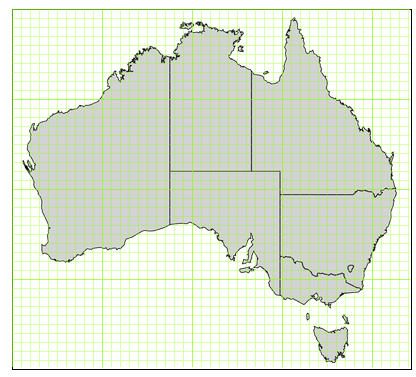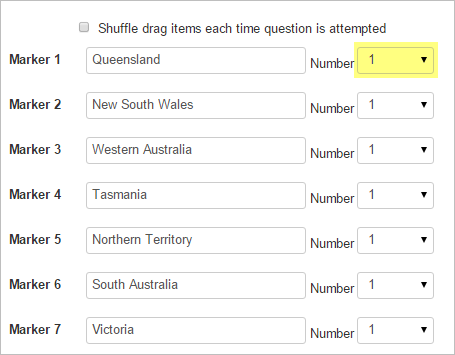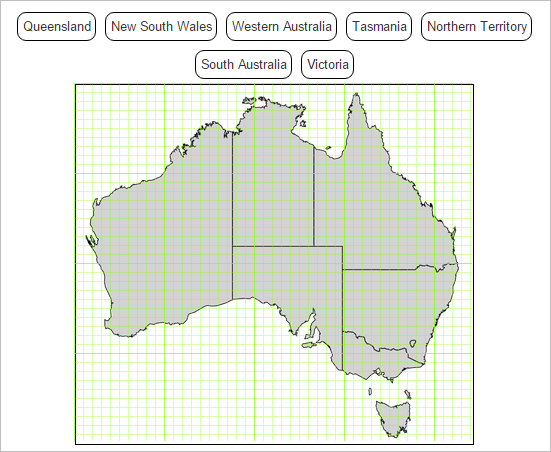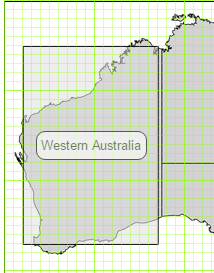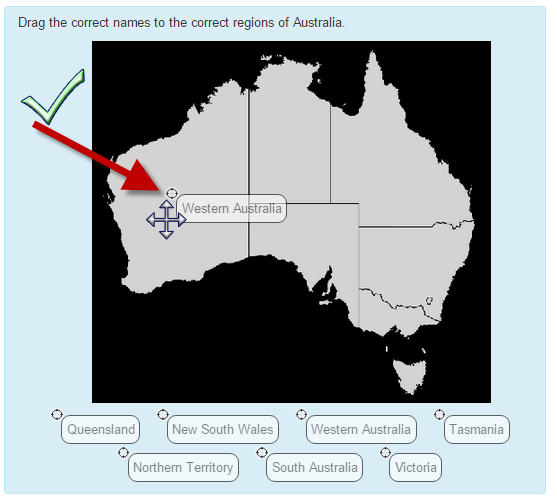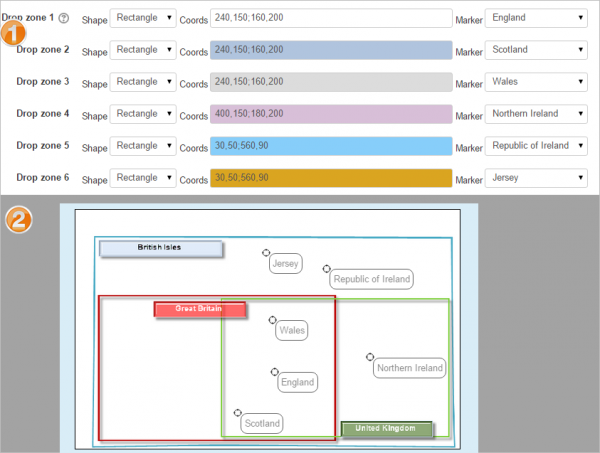Diferencia entre revisiones de «Tipo de pregunta arrastrar y soltar marcadores»
- Gestionando preguntas
- Comportamientos de preguntas
- Permisos de pregunta
- Tipos de preguntas
- Arrastrar y soltar al texto
- Arrastrar y soltar marcadores
- Arrastrar y soltar sobre imagen
- Calculada
- Calculada simple
- Calculada de opción múltiple
- Descripción
- Ensayo
- Relacionar columnas
- Respuestas incrustadas (Cloze)
- Opción Múltiple
- Ordenamiento
- Numérica
- Respuesta corta
- Relacionar columnas de respuesta corta aleatoria
- Seleccionar palabras faltantes
- Verdadero/Falso
- Preguntas de terceros
- Preguntas FAQ
Vea también:
(Germanvaleroelizondo trasladó la página Tipo de pregunta arrastrar y soltar marcador a 28/Tipo de pregunta arrastrar y soltar marcador: Moodle 2.8) |
(updated as per 2.9 Docs) |
||
| Línea 1: | Línea 1: | ||
# | {{Preguntas}}{{EnTraduccion}} | ||
This page is about the [https://moodle.org/plugins/view.php?id=234 drag and drop marker question type], which is a question type allowing students to drop markers onto an area on a background image. Drag and drop marker questions differ from [[Drag and drop onto image question type]] in that there are no predefined areas on the underlying image that are visible to the student. | |||
==How to create a question== | |||
Give the question a descriptive name to help you find it in the question bank. (Students won't see the name.) In our example, students must correctly locate regions of Australia. | |||
Add the question to the text editor, using any formatting you wish. | |||
In the '''Preview''' section, click the background image button to upload an image. Larger images will be displayed at a maxiumum 600 x 400.Your image will then display under the file upload box. Note that gridlines are visible: | |||
[[File:dragdropmarkerimageupload.png]] | |||
In the '''Markers''' section, add the words you want the students to drag onto the areas you select. | |||
[[File:ddmarkerswords.png]] | |||
In the 'Number' dropdown, you can select the number of times the marker can be used. Selecting 1 means that when it has been used once, it will no longer be available in the list. It is fine to leave the numbers as the default 'Infinite'; it just means that each marker will still remain once it has been used. | |||
In the '''Dropzones''' section, decide the shape you want the selectable areas to be:circle, polygon or rectangle. Our example uses a rectangle. In each 'Marker' dropdown, choose the item you want for that area. | |||
You will now see by your uploaded image that these names are displayed: | |||
[[File:ddmarkersimageandwords.png]] | |||
Now you need manually to add the coordinates of the areas into which you want students to position the marker. | |||
Click the question mark icon [[File:helppopup.png]] next to Drop zone 1 to see how to add these for your chosen shape. | |||
Our example uses a rectangle. We need to define four numbers: | |||
# the top left corner of our selected area, by counting the boxes in from the left... | |||
#and down from the top. Each box is ten pixels so three boxes = 300 for example. | |||
#the width of our selected area, by counting the boxes across | |||
#the height of our selected area, by counting the boxes up | |||
The numbers are separated by commas, with a semi-colon separating the corner coordinates from the size, eg: 20,50:150,200 | |||
[[File:ddcoordinatesexample.png]] | |||
The image updates immediately so you can check your accuracy and adapt the coordinates. The above co-ordinates preview as below: | |||
[[File:ddcoordinates.png]] | |||
Once all co-ordinates have been manually entered, you can save the changes and preview the question. | |||
'''IMPORTANT NOTE:''' When dragging a marker, students must position the little circle top left of the marker in the centre of the area they have selected, ''not the whole marker'', as this might cause confusion and an unexpected incorrect answer. | |||
[[File:ddexamplepositioning1.png]] | |||
===Using markers and drop zones more than once=== | |||
If 'Infinite' is selected from the 'Numbers' dropdown in the '''Markers''' section, then the markers may be used more than once. | |||
If the same coordinates must used for several markers in the '''Drop zones''' section, then more than one marker may be placed in a single area, as in the example below (1) , where students identify regions of Great Britain, the UK and the British Isles (2): | |||
[[File:partsofGBUKBI.png|thumb|600px|center]] | |||
==Accessibility== | |||
Marker questions are keyboard accessible. Use the <tab> key to move between the markers and the <arrow> keys to position the markers. | |||
==Scoring and feedback== | |||
All drop zones are weighted identically. Only drop zones that are correctly labelled gain marks. There is no negative marking of drop zones that are incorrectly labelled. | |||
If more markers are placed on the image than there are drop-zones a penalty is applied for the extra markers. If there are n drop zones and n+m markers are placed of which p are placed correctly the score is calculated as p/(m+n). | |||
If the question is used in 'interactive with multiple tries' style the marking is modified as follows: | |||
*The mark is reduced for each try by the penalty factor. | |||
*Allowance is made for when a correct choice is first chosen providing it remains chosen in subsequent tries. | |||
'''Show the number of correct responses:''' Include in the feedback a statement of how many choices are correct. | |||
'''State which markers are incorrectly placed:''' Include in the feedback a list of markers which are incorrectly placed. | |||
'''Move incorrectly placed markers back to default start position below image:''' When ‘Try again’ is clicked incorrectly positioned labels are removed. | |||
== More documentation == | |||
More [http://www.open.edu/openlearnworks/course/view.php?id=1581 documentation is available] in the [http://www.open.edu/openlearnworks/mod/oucontent/view.php?id=52747 Open University's reference manual]. | |||
== See also == | |||
* [http://moodle.org/plugins/browse.php?list=set&id=10 Other Moodle plugins from the Open University] | |||
* [http://moodle.org/plugins/browse.php?list=category&id=29 Other third-party question type plugins] | |||
* [http://labspace.open.ac.uk/course/view.php?id=3484 eAssessment at the Open University with open source software] | |||
* [http://www.somerandomthoughts.com/blog/2012/02/20/review-question-type-drag-and-drop-marker-for-moodle-2/ Review of this question type] | |||
* [http://www.youtube.com/watch?v=Tvl4GuGvtxc Video tutorial: How to Create a Question Using the Drag and Drop with Markers Question Type] | |||
[[Category:Contributed code]] | |||
[[Category:Open University]] | |||
Revisión del 17:30 4 oct 2015
This page is about the drag and drop marker question type, which is a question type allowing students to drop markers onto an area on a background image. Drag and drop marker questions differ from Drag and drop onto image question type in that there are no predefined areas on the underlying image that are visible to the student.
How to create a question
Give the question a descriptive name to help you find it in the question bank. (Students won't see the name.) In our example, students must correctly locate regions of Australia.
Add the question to the text editor, using any formatting you wish.
In the Preview section, click the background image button to upload an image. Larger images will be displayed at a maxiumum 600 x 400.Your image will then display under the file upload box. Note that gridlines are visible:
In the Markers section, add the words you want the students to drag onto the areas you select.
In the 'Number' dropdown, you can select the number of times the marker can be used. Selecting 1 means that when it has been used once, it will no longer be available in the list. It is fine to leave the numbers as the default 'Infinite'; it just means that each marker will still remain once it has been used.
In the Dropzones section, decide the shape you want the selectable areas to be:circle, polygon or rectangle. Our example uses a rectangle. In each 'Marker' dropdown, choose the item you want for that area.
You will now see by your uploaded image that these names are displayed:
Now you need manually to add the coordinates of the areas into which you want students to position the marker.
Click the question mark icon  next to Drop zone 1 to see how to add these for your chosen shape.
next to Drop zone 1 to see how to add these for your chosen shape.
Our example uses a rectangle. We need to define four numbers:
- the top left corner of our selected area, by counting the boxes in from the left...
- and down from the top. Each box is ten pixels so three boxes = 300 for example.
- the width of our selected area, by counting the boxes across
- the height of our selected area, by counting the boxes up
The numbers are separated by commas, with a semi-colon separating the corner coordinates from the size, eg: 20,50:150,200
The image updates immediately so you can check your accuracy and adapt the coordinates. The above co-ordinates preview as below:
Once all co-ordinates have been manually entered, you can save the changes and preview the question.
IMPORTANT NOTE: When dragging a marker, students must position the little circle top left of the marker in the centre of the area they have selected, not the whole marker, as this might cause confusion and an unexpected incorrect answer.
Using markers and drop zones more than once
If 'Infinite' is selected from the 'Numbers' dropdown in the Markers section, then the markers may be used more than once.
If the same coordinates must used for several markers in the Drop zones section, then more than one marker may be placed in a single area, as in the example below (1) , where students identify regions of Great Britain, the UK and the British Isles (2):
Accessibility
Marker questions are keyboard accessible. Use the <tab> key to move between the markers and the <arrow> keys to position the markers.
Scoring and feedback
All drop zones are weighted identically. Only drop zones that are correctly labelled gain marks. There is no negative marking of drop zones that are incorrectly labelled.
If more markers are placed on the image than there are drop-zones a penalty is applied for the extra markers. If there are n drop zones and n+m markers are placed of which p are placed correctly the score is calculated as p/(m+n).
If the question is used in 'interactive with multiple tries' style the marking is modified as follows:
- The mark is reduced for each try by the penalty factor.
- Allowance is made for when a correct choice is first chosen providing it remains chosen in subsequent tries.
Show the number of correct responses: Include in the feedback a statement of how many choices are correct.
State which markers are incorrectly placed: Include in the feedback a list of markers which are incorrectly placed.
Move incorrectly placed markers back to default start position below image: When ‘Try again’ is clicked incorrectly positioned labels are removed.
More documentation
More documentation is available in the Open University's reference manual.
